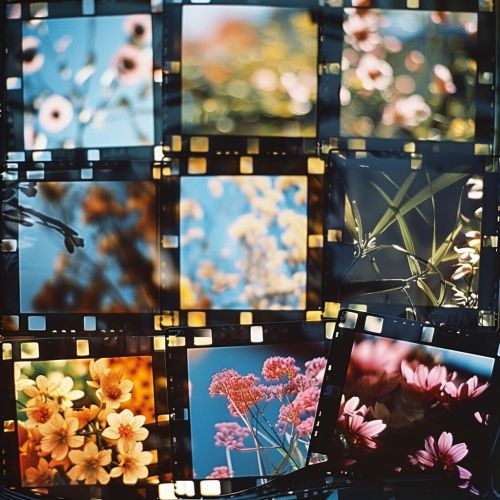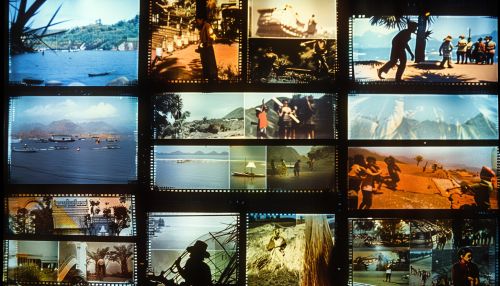Montage: Difference between revisions
(Created page with "== Definition and Origins == Montage is a film editing technique in which a series of short shots are sequenced to condense space, time, and information. This method is often used to convey a large amount of information quickly and to create a particular emotional effect. The term "montage" originates from the French word for "assembly" or "editing." The concept of montage was extensively developed by Soviet filmmakers in the 1920s, most notably by Sergei Eisenstein, w...") |
No edit summary |
||
| Line 123: | Line 123: | ||
== References == | == References == | ||
[[Image:Detail-92043.jpg|thumb|center|Series of film frames showing different scenes edited together to create a montage sequence.|class=only_on_mobile]] | |||
[[Image:Detail-92044.jpg|thumb|center|Series of film frames showing different scenes edited together to create a montage sequence.|class=only_on_desktop]] | |||
[[Category:Film Techniques]] | [[Category:Film Techniques]] | ||
[[Category:Film Editing]] | [[Category:Film Editing]] | ||
[[Category:Cinematic Techniques]] | [[Category:Cinematic Techniques]] | ||
Latest revision as of 11:21, 18 June 2024
Definition and Origins
Montage is a film editing technique in which a series of short shots are sequenced to condense space, time, and information. This method is often used to convey a large amount of information quickly and to create a particular emotional effect. The term "montage" originates from the French word for "assembly" or "editing."
The concept of montage was extensively developed by Soviet filmmakers in the 1920s, most notably by Sergei Eisenstein, who theorized that montage could be used to create new meanings that were not present in the individual shots. Eisenstein's theories of montage were influenced by the dialectical method, which posits that the juxtaposition of conflicting elements can produce a new synthesis.
Types of Montage
Montage can be categorized into several types, each serving a different purpose in film narrative and emotional impact.
Metric Montage
Metric montage is based on the length of the shots, where the editing follows a specific tempo or rhythm. The duration of each shot is determined by a pre-set pattern, regardless of the content within the shots. This type of montage is often used to create a sense of urgency or to build tension.
Rhythmic Montage
Rhythmic montage considers the visual continuity and the movement within the shots. The editing is influenced by the visual composition and the movement of objects or characters within the frame. This type of montage aims to create a visual harmony and to guide the viewer's eye through the sequence.
Tonal Montage
Tonal montage focuses on the emotional tone of the shots. The editing is guided by the emotional content and the mood of the scenes. This type of montage is used to evoke specific emotions and to create an emotional arc within the sequence.
Overtonal Montage
Overtonal montage is a combination of metric, rhythmic, and tonal montage. It considers the tempo, visual continuity, and emotional tone to create a complex and layered sequence. This type of montage is often used to convey multiple layers of meaning and to create a rich emotional experience.
Intellectual Montage
Intellectual montage juxtaposes shots to create new intellectual concepts and ideas. This type of montage is used to convey abstract ideas and to provoke thought. It often relies on the viewer's ability to make connections between seemingly unrelated shots.
Historical Development
The development of montage as a film editing technique can be traced back to the early 20th century, with significant contributions from Soviet filmmakers.
Soviet Montage Theory
Soviet montage theory emerged in the 1920s, with filmmakers such as Sergei Eisenstein, Lev Kuleshov, and Dziga Vertov leading the movement. They believed that montage could be used to create new meanings and to influence the viewer's perception.
Eisenstein's theory of montage was based on the idea of "collision" or "conflict" between shots. He believed that the juxtaposition of contrasting images could create a new synthesis and evoke specific emotions. Eisenstein's films, such as "Battleship Potemkin" and "October," are notable examples of his montage techniques.
Lev Kuleshov conducted experiments to demonstrate the power of montage. The Kuleshov Effect showed that the meaning of a shot could be influenced by the shots that preceded and followed it. This experiment highlighted the importance of editing in shaping the viewer's perception.
Dziga Vertov's approach to montage was influenced by his belief in the power of cinema to capture reality. He used montage to create a "kino-eye" or "film-eye," which could reveal truths that were not visible to the human eye. Vertov's film "Man with a Movie Camera" is a landmark in the use of montage to create a dynamic and rhythmic portrayal of urban life.
Hollywood Montage
In Hollywood, montage was used primarily as a narrative device to condense time and to advance the plot. Hollywood montages often featured a series of short shots that depicted the passage of time or the progression of events. These montages were typically accompanied by music and were used to create a sense of continuity and to maintain the viewer's interest.
One of the most famous examples of Hollywood montage is the training montage, which shows a character's progression and improvement over time. This type of montage is often used in sports films and action movies to depict the protagonist's journey towards achieving their goal.
Techniques and Applications
Montage is a versatile technique that can be used in various ways to enhance the narrative and emotional impact of a film.
Juxtaposition
Juxtaposition is a fundamental technique in montage, where contrasting images are placed next to each other to create new meanings. This technique relies on the viewer's ability to make connections between the shots and to derive meaning from their juxtaposition.
Cross-Cutting
Cross-cutting, also known as parallel editing, is a technique where two or more sequences are intercut to show events happening simultaneously. This technique is often used to create suspense and to build tension by showing the viewer multiple perspectives of the same event.
Jump Cuts
Jump cuts are abrupt transitions between shots that create a sense of discontinuity. This technique is often used to create a jarring effect and to draw attention to the editing process. Jump cuts can be used to convey a sense of urgency or to disrupt the viewer's sense of time and space.
Match Cuts
Match cuts are transitions between shots that maintain a visual or thematic continuity. This technique is often used to create a seamless transition between scenes and to guide the viewer's eye through the sequence. Match cuts can be based on visual similarities, such as matching shapes or colors, or on thematic connections, such as matching actions or ideas.
Montage Sequences
Montage sequences are a series of shots that are edited together to create a specific effect or to convey a particular message. These sequences can be used to condense time, to depict the passage of time, or to create a visual metaphor. Montage sequences are often accompanied by music and are used to create a sense of rhythm and continuity.
Impact and Influence
Montage has had a significant impact on the development of film language and has influenced various aspects of filmmaking.
Narrative Structure
Montage has influenced the narrative structure of films by allowing filmmakers to condense time and to create complex and layered narratives. The use of montage has enabled filmmakers to convey a large amount of information quickly and to create a dynamic and engaging narrative.
Emotional Impact
Montage has the power to evoke specific emotions and to create an emotional arc within a film. By carefully selecting and sequencing shots, filmmakers can guide the viewer's emotional response and create a powerful emotional experience.
Visual Style
Montage has influenced the visual style of films by encouraging filmmakers to experiment with different editing techniques and to create visually dynamic sequences. The use of montage has led to the development of new visual styles and has expanded the possibilities of film language.
Cultural Influence
Montage has had a significant cultural influence and has been used in various forms of media, including television, advertising, and music videos. The techniques developed by early filmmakers have been adapted and expanded upon in different contexts, and montage continues to be a powerful tool for visual storytelling.
Notable Examples
Several films and filmmakers are notable for their use of montage and have made significant contributions to the development of this technique.
Sergei Eisenstein
Sergei Eisenstein is one of the most influential filmmakers in the history of montage. His films, such as "Battleship Potemkin" and "October," are renowned for their innovative use of montage and their ability to create powerful emotional and intellectual effects.
Alfred Hitchcock
Alfred Hitchcock is known for his masterful use of montage to create suspense and to build tension. His film "Psycho" features a famous montage sequence in the shower scene, where the rapid succession of shots creates a sense of terror and disorientation.
Francis Ford Coppola
Francis Ford Coppola's film "The Godfather" features a notable montage sequence during the baptism scene, where the juxtaposition of the baptism ceremony and the murders creates a powerful and ironic contrast. This sequence is a masterful example of the use of montage to create a complex and layered narrative.
Martin Scorsese
Martin Scorsese is known for his dynamic use of montage to create a sense of rhythm and energy in his films. His film "Raging Bull" features a famous montage sequence that depicts the protagonist's rise and fall in the boxing world. This sequence uses a combination of slow-motion shots, rapid cuts, and visual metaphors to create a powerful emotional impact.
See Also
References


